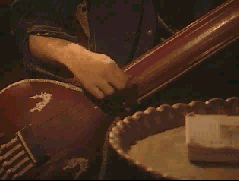

This is a drone instrument which is the an essential part of every classical concert, North or South Indian (even though the name and construction are slightly different; it is called,
"Tanpura" in the North and "Tambura" in the South). The Tambura player generally sits
behind the main artist so that they can constantly hear the drone. It is played continuously
entire length of the concert.
or South Indian (even though the name and construction are slightly different; it is called,
"Tanpura" in the North and "Tambura" in the South). The Tambura player generally sits
behind the main artist so that they can constantly hear the drone. It is played continuously
entire length of the concert.
It is usually made of wood (mostly Jackwood). It consists of a long, unfretted neck which
has tuning pegs (anywhere between 4 and 6, depending on the number of strings) inserted
into the upper end and a bowl-shaped resonator at the lower end which vibrates and
amplifies the sound. The bowl is usually made wood in the South and out of a hollowed
out gourd in the North. In the center of this bowl lies a broad, grooved bridge made of
bone or ivory. Just below the pegs is a thin plate perpendicular to the neck which has
holes for the strings to pass through. Below this is another narrow, grooved plate over
which the strings next pass and then run along the entire length of the neck over the main
bridge and are finally attatched to the bottom of the bowl. Between this attachment and
the main bridge, each string has a bead, which is used for finer tuning by moving it up or
down. Also fine silk threads called "Jiva" are used between the bridge
The bowl is usually made wood in the South and out of a hollowed
out gourd in the North. In the center of this bowl lies a broad, grooved bridge made of
bone or ivory. Just below the pegs is a thin plate perpendicular to the neck which has
holes for the strings to pass through. Below this is another narrow, grooved plate over
which the strings next pass and then run along the entire length of the neck over the main
bridge and are finally attatched to the bottom of the bowl. Between this attachment and
the main bridge, each string has a bead, which is used for finer tuning by moving it up or
down. Also fine silk threads called "Jiva" are used between the bridge and the strings. By
positioning these at the right spot, each string "rings" and this enhances the tonal
effect.
and the strings. By
positioning these at the right spot, each string "rings" and this enhances the tonal
effect.
The number of strings in a Tambura varies from four to six. In the four stringed Tambura, the two middle strings are tuned to the Tonic. The last string, which is the Bass string is tuned to the Tonic, an octave lower. The first string is usually tuned to the dominant. In the five or six stringed Tambura, the performer can choose to tune the extra string(s) to any note(s) in the Raga that is being played.

